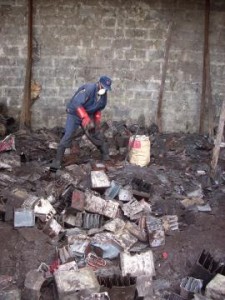Lead Acid Batteries
The global energy challenge is inciting innovation and research to develop efficient energies. Electricity has been adopted by all modern technologies. As energy cannot be created but only transferred, scientists are analysing the most efficient methods to produce, store and use electricity. Issues of distribution, pollution, security and political are involved in the process of electing adapted energies. One of the most important concerns for the use of electricity is its storage method.
Currently there are two distinct alternatives to store electricity in batteries: Lead acid batteries and Lithium technologies. Lead acid batteries were invented in 1859; the electricity results from flooding lead plates with a liquid electrolyte inside a storage container. Lead Acid batteries are broadly used thanks to their advantageous low cost and low weight. However, Lithium technology today is able to present better results as they resist up to ten times more cycles and provide more power in the same time period. But their success seems to be hampered by the intensive labour required in their manufacturing and high quality control requirements.
Lead Acid Batteries in China: Production & Use
Battery types must be selected according to the most valuable characteristics for each customer, and prices influence a lot of decision processes. Today, according to Shen Xiaoyue, an engineer affiliated to the Ministry of Environmental Protection of China, “China is the biggest producer, consumer and exporter of lead-acid storage batteries in the world.” According to China’s Statistical Yearbooks and provincial Environmental Protection Bureau statistics, manufacturing batteries in China tends to occur along the coast, 27% of them being produced in Jiangsu, 17% in Guangdong and 12% in Zhejiang. However, most of the mining, concentrating and refining processes are delivered by the interior of the country. In China, lead acid battery products are mainly used in automotive starter storage batteries, electric bicycle power batteries, fixed-type batteries for communication and energy storage batteries, but also in many other applications.
Lead acid batteries are mainly used as car batteries since they are rechargeable many times, a key factor in China where petrol can be seen as less convenient. However, after a period of time, the battery loses its capacity to store energy and becomes unusable. Lead acid batteries are used in the automobile industry as starting-lighting-ignition batteries, traction batteries, and also stationary batteries. Other designs are also widely used to store backup power supplies in cell phone towers or hospitals in case of emergencies. Those batteries are larger and are modified in order to improve the storage time and keep maintenance as low as possible. China has been facing pollution issues when handling those batteries as those batteries have a limited life cycle. At that point, they become ULABs (Used Lead Acid Batteries) and must be recycled. China faces 2.6 million metric tons of lead-acid storage batteries waste every year considered as hazardous waste under the Basel Convention. But less than 30% are reclaimed and processed following the official standards set by the government. This mismanagement of waste has been affecting the population’s health for years. Foreign experts have been brought in to address the issue of hazardous waste, and as China’s waste production shows no sign of slowing down, the demand will continue to grow as the battery market will continue to grow at least 16% for the next five years.
Decline of Lead Acid Batteries in China is Deceptive
 Today 66% of manufacturers of electric vehicles are situated in China and more than 90% of the world’s electric vehicles are made in China, mainly for the Chinese market. As lead acid batteries are used in every electric vehicle and the market is expected to expand extremely fast, those batteries seem to have a prosperous future ahead. In addition, China has purchased nearly all rare earth reserves in the world and is now controlling 95% of them. Rare earth is a key component of electric vehicles, and this near-monopolization illustrates China’s desire to continue utilizing lead acid battery technology. Lead acid batteries show great growth in demand. Lead acid application has been declining in many broad expanding industries and products, instead, lead acid traction battery power is now used mostly in bikes, forklifts, boats and vehicles for disabled. This market is projected as growing since it will be fuelled by the demand for electric vehicles. In China the lead acid battery output is forecasted at 240 million kVA.
Today 66% of manufacturers of electric vehicles are situated in China and more than 90% of the world’s electric vehicles are made in China, mainly for the Chinese market. As lead acid batteries are used in every electric vehicle and the market is expected to expand extremely fast, those batteries seem to have a prosperous future ahead. In addition, China has purchased nearly all rare earth reserves in the world and is now controlling 95% of them. Rare earth is a key component of electric vehicles, and this near-monopolization illustrates China’s desire to continue utilizing lead acid battery technology. Lead acid batteries show great growth in demand. Lead acid application has been declining in many broad expanding industries and products, instead, lead acid traction battery power is now used mostly in bikes, forklifts, boats and vehicles for disabled. This market is projected as growing since it will be fuelled by the demand for electric vehicles. In China the lead acid battery output is forecasted at 240 million kVA.
But this promising technology is challenged by several rising alternatives. In spite of the sales statistics results, many threats have been identified and potentially could replace the lead acid totally. Specialists believe that alternatives will take over since technological progresses are constantly being made. Regular vehicles are seeing their “stop start” that is demanding less battery energy. Electric vehicles are starting to replace regular on-road ones. In China, this phenomenon is already very visible for motorbikes, since about 90% of the world’s e-bikes were sold in China in 2012. The new technology embodied by the lithium battery is also a possible threat to the lead acid battery but it price still remains to high. Close attention to this technology should be kept in mind.
This trend to search for the most efficient technology is aligned with modern though pollution laws. R&D and alternatives will be favoured in the upcoming years at the expense of ineffective technologies meaning that many are predicting lead acid batteries could became obsolete very fast. As said by Xia Qing, Chief Engineer and former Vice President of China Research Academy of Environmental Sciences “Low cost high pollution times have gone away.”
Green future for Lead Acid Batteries in China?
However, while solar and wind-power especially are creating a much greener energy production future for China, the issue of energy storage remains a serious one. As China seeks to integrate renewable energy sources into the country’s power grid, the issue of where to store the excess energy generated by wind power and photovoltaic power facilities will require larger and larger storage facilities to remain viable. As a high-security, low-cost option, lead acid batteries in China have the potential to remain a valuable part of the country’s grid storage technology so long as the environmental impact can be addressed. More and more lead acid battery manufacturers are undergoing serious green energy reforms as laid out by the “Suggestions for Promoting Standardized Development of Lead-Avid Battery and Secondary Lead Industry” laid out by the Ministry of Environmental Protection. So while China’s green energy moves it away from the use of lead acid batteries in more commercial uses, its use as an integral part of grid storage is looking very likely.
Sources:
https://www.ehjournal.net/content/12/1/61
https://usa.chinadaily.com.cn/china/2013-12/12/content_17168678.htm
https://www.futuremarketinsights.com/pressreleases/details/lead-acid-battery-market




